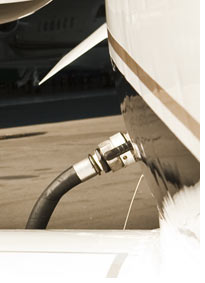March 16, 2012
The price of oil has risen nearly 20 percent in the last six months, to well over $100 a barrel, pushing up aviation fuel costs and forcing business aircraft operators to do redouble their focus on fuel planning.

“We definitely see increased interest in fuel management solutions when oil prices go up,” said Kevin Moller, president of FuelerLinx, a provider of software for comparing real-time prices, tankering analysis and fuel buying. Because it’s such a large share of a flight department’s operating expenses, finding new ways to save on fuels costs is an imperative.”
Prices for Jet A fuel for turbine aircraft and 100 low lead aviation gasoline (100LL avgas) are over $6 a gallon in some parts of the country. Driving the rise in prices are new oil sanctions on Iran imposed by the European Union; Iran’s threatened response to blockade the critical shipping lanes through the Strait of Hormuz; ongoing instability in the region caused by the Arab Spring; and inexorably rising demand from expanding economies, such as China and India.
“Anybody doing their mission planning right now is going to consider current and projected fuel pricing,” said Neil Brackin, director of air transportation at Minneapolis-based General Mills. “I wouldn’t be surprised to see companies delay equipment purchases or look at airplanes with lower fuel burn.”
Before cutting back on flights or equipment, Moller suggested changes in day-to-day operations to save on fuel, such as:
- Get more direct routings.
- Dial back on the throttle speed.
- Consider alternate tech stops at airports surrounding your usual stops, where fuel might be cheaper.
- Check the prices and fees at different FBOs on the same airfield.
Making fuel planning more difficult are the widening regional differences in fuel prices across the country and confusing FBO ramp fees. “We might be in a new reality, where the prices we’re seeing now won’t go down much,” said Brackin. “Using fuel programs to make your variable costs more predictable is just part of the job now.”
Until very recently, fuel planning was a very labor-intensive exercise, requiring schedulers or pilots to spend hours downloading price quotes from each supplier, calling to negotiate volume discounts and comparing complex spreadsheets for each stop on an itinerary.
“If a flight department wants to save money, they’ve got to diversify their fuel network,” said Moller. “We recommend working with at least six contract-fuel vendors, and it’s very difficult to do that without technology.” Programs like FuelerLinx can simplify the process, but Moller emphasized operators should still try to make deals directly with FBOs, using fuel cards and negotiating home-base discounts.
A strong home-base discount is one reason to consider tankering fuel on multi-stop trips. “Tankering is huge,” said Moller, “It’s a way for flight departments to maximize their savings by taking on fuel where it’s most advantageous.”


 International Business Aviation Council Ltd.
International Business Aviation Council Ltd.